What is the difference between crewing cruise ships and super yachts?
Cruise ships and super yachts are both large vessels that are staffed by crew members who make sure things are running smoothly.
Don't let that statement fool you, though—the experience of working on each vessel is quite different. In this article, we'll explore some key differences between working on a cruise ship and working on a super yacht.
Let's dive in!

Cruise Ships vs. Super Yachts: Specifications
The first thing to note is that cruise ships are generally much larger than super yachts. The average cruise ship is about 900 feet (ca. 274 meters) long, while the average super yacht is only about 150 feet (ca. 46 meters) long.
This difference in size means that there are also differences in the number of crew members. A typical cruise ship will have a crew of around 800 to 1,500 people, while a typical super yacht will have a crew of about 10 to 20 people.
Cruise Ships vs. Super Yachts: Work Hours
Another key difference between working on a cruise ship and working on a super yacht is the work hours. On a cruise ship, crew members typically work long hours—up to 10 hours per day—and will have they often have to work on weekends and holidays.
On a super yacht, crew members usually work around 8-10 hours per day, and they typically have more time off, dependant on the yacht’s itinerary. This difference is due in part to the fact that cruise ships carry more passengers and offer more amenities, including:
- restaurants
- live entertainment
On a super yacht, on the other hand, the focus is more on luxury and relaxation, so there can be fewer work hours.
Cruise Ships vs. Super Yachts: Work Environment
The work environment is another area where cruise ships and super yachts differ. On a cruise ship, the work environment is fast-paced. There are usually large numbers of passengers, and things do get busy.
On a super yacht, the work environment is typically more relaxed. There is often a higher crew to guest ratio, meaning there are more people to handle the workload. And the fact that there are fewer people in general makes for a quieter atmosphere.
That said, cruise ships typically offer their crew members dedicated crew areas for relaxation, while super yachts typically do not.
Cruise Ships vs. Super Yachts: Salaries
Finally, let's talk about salaries. Crew members on cruise ships typically earn less than crew members on super yachts.
This is due in part to the fact that super yacht owners are typically looking for crew members with exceptional maritime skills and experience. They are also willing to pay more for luxury and exclusivity.
Of course, salaries vary depending on the specific cruise ship or super yacht, so it's always best to do your research before applying for a job.
What Are the Requirements for Crew on a Cruise Ship or Super Yacht?
Now that we've gone over some key differences between working on a cruise ship and working on a super yacht, you might be wondering what requirements you need to meet in order to work on either one.
For the most part, there are very few formal requirements for entry level positions. You'll need:
- a valid passport
- a seafarers medical exam
- a STCW Basic Training certificate
- a firm grasp of the English language
However, these are the bare minimum requirements. If you're looking for a higher-level position, such as a management or officer mate position, you'll need additional experience and qualifications.
It's also important to note that most cruise lines and super yacht owners prefer to hire crew members who have experience working in customer service.
Finally, it's worth mentioning that many cruise lines and super yacht owners require their crew members to sign a contract. This contract can last for up to 6-8 months, and it can typically include a clause that requires you to pay back the cost of any training the company has paid, should you leave the job early.
How To Land a Job on a Cruise Ship or Super Yacht
1. find opportunities.
If you're interested in working on a cruise ship or super yacht, the first thing you need to do is search online for job postings on our website.
2. Complete Your Application
Once you've found a job listing that interests you, the next step is to complete your application. Ensure that you have an up to date resume to submit as part of your application.
If there are any requirements that you don't meet (e.g., STCW Basic Training certification), you'll need to take care of those before you can complete this step. Luckily, there are plenty of maritime skills academies (such as the Maritime Skills Academy ) that can help you get up to speed.
3. Interview and Training
After you've submitted your application, the next step is an interview.
For cruise ship jobs, this will likely be a video interview with a hiring manager - but every cruise line is different. For super yacht jobs, the interview process is less systematic.
You might have an in-person meeting with the captain or owner of the yacht, followed by a trial period where you'll work as a deckhand or stewardess to see if you're a good fit for the job.
Join a Crew Today!
If you're interested in working on a cruise ship or super yacht, now is the perfect time to start your job search !
Both industries are booming, and there are plenty of opportunities for motivated individuals with the right skills and qualifications. Just remember to do your research before applying for any job, and don't forget to complete your STCW Basic Training certification—it's one of the most important requirements for any maritime job.
Sign Up For News & Updates
- Terms & Conditions " required=""> I agree to your Terms & Conditions *

- Industry Updates
- General Boating News
- Something Else
- I am happy to receive email updates from Viking Crew
- I agree to your Terms & Conditions
Ready To Apply?
Apply with 1 click with your viking crew account..
Don't have one? Click below to register and complete your profile
Email Address
Remember Me

Register With Viking
Search saved.
Manage your search preferences in your user profile
Thankyou for your message.
We aim to respond to all queries within 24 hours. Still looking for the perfect job? Start a search now
Thank you for signing up, keep an eye on your inbox. Ready to start your job search?
- Our Clients
- Our Offices
- Associations & Accreditations
- Crew Your New Build Yacht Projects
- Yacht Services Overview
- Funding and Grants
- Maritime Labour Convention (MLC)
- Green Crew Pathway
- Mental Health & Wellbeing
- Women in Maritime
- MCA Wellbeing at Sea Tool
- Newsletters


Yacht vs Cruise Ship: Key Differences Explained
Many travelers look at luxury yacht rentals and cruise ships when planning a vacation at sea. But there are some major distinctions between these two options. Understanding the key differences can help you choose the best one to suit your needs and expectations.
Size and Capacity
The most obvious difference is size and guest capacity. Cruise ships are massive, housing 2000-6000 passengers.
Even small ships carry 600+ people. In contrast, chartered yachts max out around 12 guests, with typical capacities of 6-10. The intimate scale ensures an exclusive escape.
Itineraries and Flexibility
Cruises sail along fixed routes and strict schedules, whereas yacht charters offer total itinerary flexibility. Craft your own custom route with a captain. Spend more time in spots you love and bypass others. The only fixed elements are your start/end ports.
Onboard Experience
The onboard ambiance varies dramatically between the two. Cruise ships feel like floating cities with crowds everywhere. You’ll share amenities with thousands of fellow passengers. Chartered yachts provide a private, peaceful retreat catered to you. No queues or sharing.
Activities and Entertainment
Both offer plenty of amenities, but the vibe is different. Cruises offer fun activities like casinos and shows, while yachts provide relaxation and adventures like snorkeling and fishing. The choice depends on your interests.
Service and Cuisine
With thousands of guests, cruise staff and dining cannot provide truly personalized service. You get more staff interaction on a yacht, including a captain dedicated to your charter. Included in the experience is fine dining with customized menus and premium alcohol.
For an exclusive getaway on your terms, a private yacht charter reigns supreme. But mass market cruises suit travelers who enjoy crowds and scripted entertainment. Evaluate your priorities to choose the best seafaring vacation.
Booking and Costs
Booking a cruise is relatively simple through major cruise lines or agencies, while yacht charters require researching reputable brokers and charter companies, of which there are many. Cruise fares per person are lower, but a fully crewed yacht divided among guests can still be competitive. Keep costs variable by booking a bareboat yacht charter.
Destinations and Departure Ports
Cruise ships certainly provide a wide variety of itineraries, but their large size limits them to major cruise ports. Yachts can access small coves, secluded islands, and exotic locales that mega-ships can’t reach. Many more departure ports are accessible for yacht charters too.
Onboard Accommodations
Staterooms on a cruise provide basic comfort, often with an ocean view. Yachts feature lavish staterooms and master suites with hotel-style amenities. You’ll get complete privacy, often with en-suite bathrooms. Some large charter yachts rival small boutique hotels in luxury. .
Health and Safety
Mass gatherings on cruises can enable the rapid spread of illnesses like COVID or norovirus. Yachts provide isolation from crowds and allow immunocompromised guests to vacation safely. Strict protocols keep private yachts disinfected, and both options mandate safety drills and procedures.

Read Our Billfish Policy

Our Crews Prefer


Yacht vs Cruise Ship: A Comprehensive Comparison

- Recent Posts
- Coolife Luggage Review: The Ultimate Travel Companion – February 5, 2024
- Monos Luggage Review: Is the Hype Worth It for Monos Carry-On Suitcases? – February 2, 2024
- Montage Laguna Beach: Luxurious Retreat by the Sea – February 1, 2024

What is a Yacht?
A yacht is a private, luxury watercraft designed for leisure use. They range from smaller vessels that can be sailed or driven by the owner, to superyachts that require a professional crew to operate. Yachts are known for their luxury amenities and personalized services.
What is a Cruise Ship?
A cruise ship, on the other hand, is a large passenger ship used for pleasure voyages. Cruise ships are essentially floating resorts, offering a wide range of amenities and activities. They can accommodate hundreds or even thousands of passengers.
Yacht vs Cruise Ship: The Key Differences
There are several key differences between a yacht and a cruise ship, including size, amenities, travel experience, and privacy.
The most obvious difference is size. While yachts can be quite large—superyachts often exceed 100 feet in length—cruise ships are significantly larger. Some of the biggest cruise ships can carry more than 6,000 passengers and 2,000 crew members.
Both yachts and cruise ships offer luxury amenities, but the scope differs greatly. Cruise ships often feature multiple dining venues, bars, pools, fitness centers, spas, theatres, and even shopping malls. Yachts, while smaller, offer high-end, personalized amenities like private chefs, hot tubs, and custom entertainment systems.
Travel Experience
The travel experience also differs significantly. Cruise ships follow set itineraries with scheduled stops at various ports. Yacht charters, on the other hand, offer more flexibility, allowing you to customize your itinerary and explore less crowded, off-the-beaten-path destinations.
Privacy is another critical difference. On a yacht, you share the space with only your chosen guests and crew. On a cruise ship, you’re traveling with a large number of other passengers, which can affect your privacy.
Superyacht vs Ship: A Unique Comparison
A superyacht is a large, privately-owned yacht that is professionally crewed. But how does it compare to a ship?
Size and Capability
While superyachts are smaller than cruise ships, they are often more technologically advanced. They are designed to deliver a luxurious, personalized experience and can navigate areas that larger ships can’t access.
Luxury and Exclusivity
Superyachts are synonymous with luxury and exclusivity. From high-end finishes and bespoke interiors to personalized service and gourmet dining, superyachts offer a level of luxury that even the most upscale cruise ships struggle to match.
Cruise Ship vs Yacht Vacations: Which One to Choose?
The choice between a cruise ship vacation and a yacht charter depends on your preferences and expectations.
If you’re traveling with a large group or want to meet new people, a cruise ship might be a better option. If you prefer a more intimate, private experience with family or friends, a yacht charter would be ideal.
Cruise ships offer fixed itineraries and pre-planned activities, which can be great for those who prefer a structured vacation. Yacht charters offer more flexibility and freedom to explore at your own pace.
Cruise ship vacations are generally more affordable, with costs spread out among many passengers. Yacht charters can be more expensive, but they offer a unique, personalized experience that many find worth the higher price tag.
How Charters Deliver a Truly 5-Star Experience
Yacht charters are known for delivering a truly 5-star experience, offering unparalleled luxury, privacy, and flexibility.
Personalized Service
With a professional crew at your disposal, you can expect personalized service tailored to your preferences. This can include everything from custom menus prepared by your private chef to itinerary planning based on your interests.
Luxury Amenities
Yacht charters offer high-end, luxury amenities. From plush accommodations and private dining areas to onboard entertainment systems and water sports equipment, everything is designed for your comfort and enjoyment.
Flexibility
One of the biggest advantages of yacht charters is the flexibility they offer. You can set your own pace, choose your destinations, and change your itinerary as you wish.
In conclusion, while both yachts and cruise ships offer luxurious water travel experiences, they cater to different needs and preferences. Whether you prefer the intimate luxury of a yacht charter or the extensive amenities and social opportunities of a cruise ship, there’s a perfect option out there for your next vacation.
Related posts

Coolife Luggage Review: The Ultimate Travel Companion

Monos Luggage Review: Is the Hype Worth It for Monos Carry-On Suitcases?

Montage Laguna Beach: Luxurious Retreat by the Sea

Secrets Maroma Beach Riviera Cancun Explored: Journey to Coastal Bliss

Paradise Showdown: Maui vs Kauai – Which Hawaiian Paradise Wins Your Heart?

Bora Bora vs Maldives: The Ultimate Paradise Showdown!

Unveiling Santorini’s Top 10 Beach Clubs: Where Luxury Meets Coastal Bliss

Brics Luggage Review: The Perfect Travel Companion for the Jetsetter!
Recommended.

The Ultimate Showdown: Travelpro vs London Fog – Which Luggage Reigns Supreme?

Travelpro vs Delsey: Battle of the Titans – Which Luggage Brand Reigns Supreme?

Sunny Escapes: San Juan Water and Beach Club Unveiled

Unveiling Miami’s Finest: The Top 10 Beach Clubs for Ultimate Coastal Escapes

Get Connected
Follow Ample Journey on social media for travel tips, packing hacks, and latest updates!
Sub To Newsletter
Subscribe to our newsletter to get the latest travel tips, packing hacks, gear reviews, and bargain deals straight to your inbox. We hate spam, so we’ll send only the most important stuff.

Ample Journey is a dedicated team of passionate travel enthusiasts who are committed to enriching the travel experiences of tourists, adventure seekers, and travelers of all kinds in a heartwarming and professional manner.
2 Burton Rd, Wool, Wareham BH20 6EY, UK
Yacht vs Cruise Ship: Luxury Travel Choices
- January 24, 2024
Which is the Ultimate Luxury Travel Choice: Yacht or Cruise Ship?
Introduction
When it comes to luxury travel, there are various options available, but two that often stand out are yachts and cruise ships. Both offer unique and extravagant experiences, allowing travelers to explore the open waters in style. While some may argue that a yacht provides the epitome of luxury, others may argue that a cruise ship offers more amenities and entertainment options. So, which is the ultimate luxury travel choice? Let's dive deeper into the world of yachts and cruise ships to understand the distinct features and advantages each offers.
The Allure of a Yacht
For many, the thought of cruising on a private yacht elicits images of opulence and exclusivity. Yachts are often associated with the rich and famous, offering a level of privacy that can't be matched by a cruise ship. Imagine sailing through crystal-clear waters, surrounded by breathtaking views, and basking in the privacy of your own floating paradise.
A yacht provides a more intimate experience, allowing you to escape the crowds and enjoy a tailor-made vacation. With a dedicated crew catering to your every need, you can truly relax and unwind. Whether you desire a tranquil escape or an adventurous expedition, a yacht can fulfill your every desire. From remote islands to hidden coves, the possibilities for exploration are endless.
Advantages of a Cruise Ship
While yachts offer exclusivity, cruise ships provide a different kind of luxury – a floating city filled with entertainment, activities, and world-class amenities. With multiple dining options, theaters, casinos, spas, and shopping centers, cruise ships are like mini-resorts on water. They cater to a wide range of interests, ensuring there is something for everyone.
When it comes to variety, a cruise ship surpasses a yacht. With different destinations and itineraries, you can explore multiple countries and cities during a single trip. Additionally, cruise ships often have onboard pools and water parks, offering fun for families and groups. Whether you want to relax by the pool, catch a Broadway-style show, or engage in thrilling water sports, a cruise ship has it all.
The Ultimate Comparison: Yacht vs. Cruise Ship
Now that we have explored the allure of both yachts and cruise ships, let's delve deeper into a detailed comparison to help you make an informed decision when planning your next luxury vacation.
1. Exclusivity and Privacy
One of the most significant advantages of a yacht is the exclusivity and privacy it offers. On a yacht, you have the freedom to sail to remote destinations away from the crowded tourist spots. You can escape the hustle and bustle of everyday life and enjoy serenity on the open waters. Additionally, a yacht allows you to customize your itinerary based on your preferences, ensuring a truly personalized experience.
On the other hand, cruise ships are known for their large capacity, accommodating thousands of passengers. While they do offer private cabins, the overall experience is more communal. You will be sharing the ship's facilities and common areas with a significant number of people. If you prefer a more intimate and secluded experience, a yacht is the way to go.
2. Range of Amenities and Activities
When it comes to amenities and activities, cruise ships take the lead. These floating resorts boast an impressive range of options to keep you entertained throughout your journey. From art galleries to fitness centers, mini-golf courses to rock climbing walls, cruise ships are designed to cater to all interests. You can indulge in spa treatments, attend cooking classes, participate in dance lessons, or simply relax by the pool with a refreshing cocktail.
While yachts offer luxurious amenities such as jacuzzis, sun decks, and even helipads, the range and scale of activities are more limited. Yachts are ideal for those seeking a peaceful and serene vacation, away from the hustle and bustle of a cruise ship. If you crave a dynamic and vibrant atmosphere with endless entertainment options, a cruise ship will provide the ultimate experience.
3. Dining Experiences
Both yachts and cruise ships offer exceptional dining experiences, but they differ in style. On a yacht, you can enjoy personalized menus created by world-class chefs, catering to your specific tastes and dietary requirements. Your onboard chef will prepare gourmet meals using the freshest ingredients, ensuring a culinary journey like no other. You can dine alfresco under the stars or inside a luxurious dining room, relishing every bite in a private setting.
Cruise ships, on the other hand, offer a plethora of dining options. From casual buffet-style restaurants to elegant fine dining establishments, you can choose from a wide range of cuisines and culinary experiences. Cruise ships often have renowned celebrity chefs on board, providing an opportunity to indulge in their creations. Whether you crave sushi, steak, or international delicacies, a cruise ship will satisfy your taste buds.
4. Exploration and Itineraries
When it comes to exploration, yachts offer unparalleled freedom and flexibility. With a yacht, you have the ability to chart your own course and explore off-the-beaten-path destinations that are inaccessible to larger ships. Yachts can navigate through narrow channels, secluded bays, and shallow waters. You can anchor near pristine beaches or remote islands, immersing yourself in the beauty of untouched nature. The intimate size of a yacht allows you to discover hidden gems that are often missed by larger vessels.
Cruise ships, on the other hand, offer a wide range of itineraries, taking you to multiple destinations in a single trip. From bustling cities to tropical paradises, you can experience the diversity of various ports of call. Cruise lines carefully curate their itineraries, ensuring you have ample time to explore each destination. While cruise ships may not have the flexibility of a yacht, they make up for it by offering a broader range of experiences.
In the end, choosing between a yacht and a cruise ship comes down to personal preferences and the type of luxury experience you seek. If you value privacy, exclusivity, and customizable itineraries, a yacht is the perfect choice. On the other hand, if you crave an abundance of amenities, entertainment options, and the chance to explore multiple destinations effortlessly, a cruise ship is your best bet.
Both yachts and cruise ships offer unique and luxurious experiences, catering to different tastes and preferences. Whether you desire a secluded escape or a vibrant journey filled with entertainment, there is an option that will suit your desires. So, weigh the pros and cons, consider your preferences, and embark on a luxury travel adventure that is tailor-made for you.
Remember, luxury is a subjective concept, and what matters most is how you define it. So, choose the option that aligns with your idea of the ultimate luxury and set sail on a remarkable journey that will create lifelong memories.
Leave a Reply Cancel reply
Your email address will not be published. Required fields are marked *
Save my name, email, and website in this browser for the next time I comment.
Hidden Treasures of Bhutan: Monasteries and Mountains
Mexican food vs american food: a flavorful culinary comparison, you may also like.
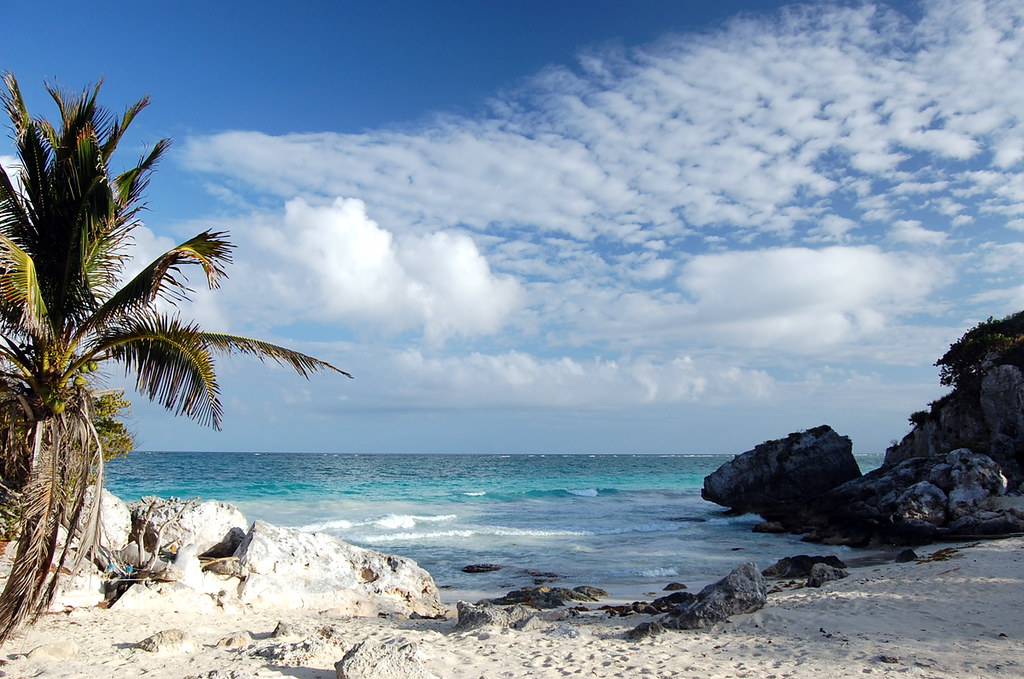
Bahamas vs Aruba: Caribbean Vacation Destinations
- February 14, 2024
Orange Beach vs Gulf Shores: Alabama Gulf Coast Destinations

Saint Petersburg vs Moscow: A Comparison

Tokyo Haneda vs Narita: Choosing the Best Airport
- February 13, 2024


Milan vs Florence: Exploring Italian Cities
Hermosa vs Bonita: Spanish Beach Comparison
- CruiseMapper
- Ships and Lines
Cruise Ship Size Comparison, Dimensions
Compare cruise ship sizes by length, weight (tonnage), height, width/beam. Review cruise ship dimensions in both meters and feet, and FAQ information, definitions.
Cruise ship size comparison
In our huge table below there's a list of all most famous, ever best passenger cruise ships sorted by name. This survey also offers smaller cruise ships size comparison of top luxury all-inclusive vessels with gross tonnage even lesser than 5,000 GT. Now the list of all ship sizes related and integrated articles:
- passenger capacity of cruise ships
- cruise ships cost
- newest cruise ships (on order/under construction)
- list of the biggest cruise ships of the world
- world's largest cruiseship building companies
- cruise line companies list

Length of a cruise ship (Length Overall / LOA)
The cruise ship length is professionally referred to as LOA (length overall), meaning the maximum length between the two most distant points on its hull. LOA may also include the tip of the bowsprit - the pole extending from the ship's prow (usually on tall sailing ships, yachts, and smaller boats). The bowsprit is the "winning" part of the ship when competing in a race or during trials/speed tests.
Another passenger cruise ship length measuring (though not included in this survey) is called LWL. LWL signifies "loaded waterline length" (or just "waterline length"). It excludes the total length, denoting only the length at the point where the vessel sits in the water. The LWL measure plays an important role when assessing some ship properties, like "hull speed" (aka "displacement speed"), water displacement, the amount of paint needed for the ship's bottom, etc.
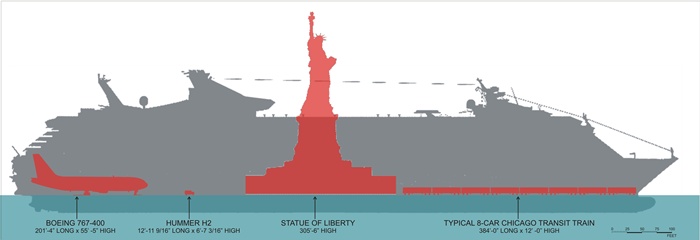
Longest cruise ship in the world
The longest cruise ships by size also occupy the first two positions in the list of the largest cruise ships of the world by passenger capacity and gross tonnage. The humongous Royal Caribbean's floating cities Allure and Oasis boast the whole 360 meters in length (1,181 ft), and breadth of 47 meters (154 ft), the unbelievable for a passenger cruise ship tonnage of 225,300 tons, and max crew-passenger capacity of almost 8,500 (2,170+6,300) - each!
Weight of a cruise ship (tonnage) and draft
The size (tonnage weight) of a cruise ship is measured in "gross tonnage" (GT). It relates to the vessel's internal volume (keel to funnel* and to the outside of the hull) and applying a mathematical formula. The cruise ship tonnage is generally used for determining registration fees, port fees, safety rules, regulations. Another ship data (though not included in this survey) is the vessel's "deadweight tonnage" (DWT), which is the weight a vessel can safely carry (cargo, passengers, etc).
The cruise ship draft (or draught) measures the number of meters/feet from the waterline to the lowest point of the keel - or the ship's "invisible" portion below the surface (and especially when loaded). The cruise ship's draft is very important when considering docking in a particular port, sailing through channels or the inland waterways of the continents (rivers and canals).
*Note: Actually, the ship's funnel is the only part of the enclosed interior space that is NOT included in its Gross Tonnage measurement.
Cruise ship weight
As one of our fans Mr John Spooner (cruiser / Retired Master Mariner) have pointed out, the "Gross Tonnage" weight is a measurement of VOLUME, and not of MASS. GT is an index related to marine vessels' overall internal volume. According to Wikipedia's definition:
- "Gross Tonnage" (GT) calculations are based on the volume of all the ship's enclosed spaces.
- "Gross Register Tonnage" (GRT) is the vessel's total internal volume measured in "register tons" (each ton equals 100 ft3 / 2,83 m3).
- Neither GT nor GTR measures the vessel's displacement (mass), but really show how big cruise ships are.
- "Deadweight Tonnage" (DWT) measures how much weight a cruise ship (or any of the marine vessel types) can carry safely. This a weighted sum of the vessel's cargo (incl provisions, passengers, crew), fuel, water (fresh and ballast), etc.
- "Displacement Tonnage" is how much weight the water that a cruise ship (any vessel) displaces when floating (the total weight of the ship / including its contents). Displacement is usually applied to the navy rather than commercial marine vessels. It is measured when the ship is loaded at full capacity.
Compare cruise ship sizes

What’s the Difference Between Yacht and Cruise? (What You Need To Know)
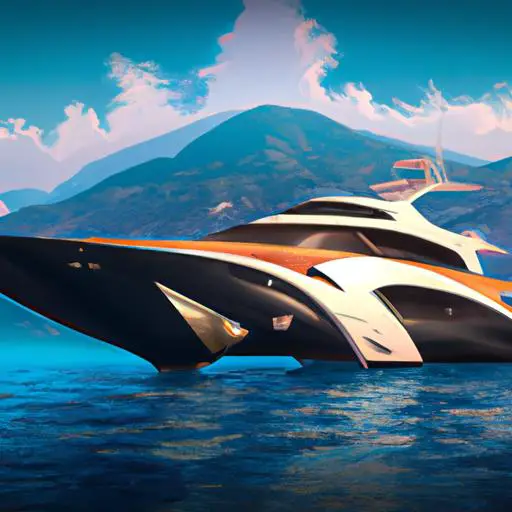
When deciding on a vacation getaway, it can be difficult to decide between a yacht and a cruise.
From the cost to the amenities to the privacy and types of activities, there are a variety of factors to consider when making your decision.
In this article, we’ll take a closer look at what the differences are between a yacht and a cruise, and the pros and cons of each.
You’ll be sure to find the perfect vacation getaway with all the information you need to make an informed decision.
Table of Contents
Short Answer
Yachts are smaller, private vessels that are designed for luxury leisure and recreational activities, such as sailing and fishing.
Cruises are large, commercial ships that are designed to transport passengers on longer voyages and are often used for leisure activities like sightseeing and entertainment.
Yachts typically have a smaller crew and guests, while cruise ships have a larger crew and can accommodate hundreds of passengers.
Additionally, yachts are more expensive to rent or own, whereas cruises are more affordable for the average traveler.
Definition of Yacht
A yacht is a recreational boat or vessel that is typically used for luxury and leisure.
It is usually privately owned and used for a variety of activities.
Yachts come in all shapes and sizes, ranging from smaller vessels designed for fishing and day trips to larger boats for hosting events and overnight stays.
Yachts are typically more expensive than cruises because they offer fewer amenities and more privacy.
They are often used for private sailing trips, fishing trips, or for hosting special occasions such as weddings, birthdays, and anniversaries.
Many yachts are even equipped with amenities such as hot tubs, bars, and water slides.
Yachts are also an ideal choice for those looking for a more intimate experience, as they are often not filled to capacity.
Definition of Cruise

Cruises are large ships that are designed for commercial purposes, such as vacation and sightseeing trips.
They are usually rented out by companies that specialize in providing trips such as these.
Cruises usually have multiple stops along the way, allowing passengers to explore different cities or countries as they travel.
Cruises are typically more affordable than yachts and have more amenities, such as restaurants, clubs, casinos, lounges, and more.
They also tend to be much larger than yachts, allowing them to accommodate more people and activities.
Passengers on cruises may also have the option to participate in organized activities and excursions, such as snorkeling, sightseeing, and more.
Cost Comparison
When comparing the cost of yachts and cruises, it’s important to consider the size and amenities of each.
Yachts tend to be more expensive than cruises, as they are typically smaller and offer fewer amenities.
Yachts are often rented for private sailing trips, fishing, or for hosting events, and the cost of renting a yacht can depend on the size, type, and amenities of the vessel.
On the other hand, cruises are larger ships that are designed for commercial purposes, such as vacation and sightseeing trips.
Cruises are generally less expensive than yachts, as they are often filled to capacity and offer a range of amenities and activities.
In addition, many cruises offer package deals that can save money and make the cost of the trip more affordable.
Amenities Comparison

When it comes to amenities, there are some key differences between yachts and cruise ships.
Yachts tend to offer fewer amenities but provide more privacy than cruises.
Yachts typically have one or two bedrooms, a kitchen, and a living area, while cruises typically have larger bedrooms, multiple dining options, and a variety of entertainment and activities such as swimming pools, spas, and fitness centers.
Yachts also often have a captain and crew to help you during your voyage, while cruises typically have a larger staff of professionals.
Yachts tend to provide more personalized and luxurious services for guests, such as private chef experiences and butler services.
Cruises, on the other hand, often offer more variety in terms of entertainment and activities for guests, such as live music, shows, and excursions.
Yachts are typically more expensive than cruises, due to the smaller size and more luxurious amenities.
However, they can be a great option for those looking for a more intimate and exclusive experience.
Cruises offer more variety and affordability, making them a great choice for larger groups or those looking for a more budget-friendly option.
Privacy Comparison
When it comes to privacy, the most notable difference between a yacht and a cruise lies in the size of the vessel.
Yachts are typically smaller vessels that can accommodate fewer people, making them ideal for those who prefer to have a more intimate experience.
With a yacht, youll have more control over who you invite on board and wont have to worry about dealing with large crowds.
Cruises, on the other hand, are much larger in size, often filled to capacity, and can provide a less private experience.
Youll have to share the boat with not just other passengers, but also the crew, meaning you wont have as much control over who is on board.
However, cruises do offer more activities, entertainment, and amenities than a yacht, which can make up for the lack of privacy.
Types of Activities

When it comes to the types of activities available on yachts and cruises, there are some notable differences.
On a yacht, the activities you can partake in are typically more luxurious and leisurely in nature, such as private sailing trips, fishing, or hosting events.
Yachts are usually smaller than cruises, so the activities are usually more intimate and tailored to the individual or group of travelers.
Cruises, on the other hand, are designed for commercial purposes, such as vacation and sightseeing trips.
Cruises typically have a variety of activities on board, such as live shows, swimming pools, and various restaurants, as well as excursions to explore nearby destinations.
Cruises are also known for offering more extensive activities than yachts, as they are often filled to capacity with travelers from all over the world.
While yachts and cruises both offer unique experiences, it is important to consider the type of activities you wish to partake in when deciding which option is best for you.
Yachts are better suited for those who prefer more intimate and private settings, whereas cruises are better for those looking for a more social and action-packed experience.
Pros and Cons of Yacht vs. Cruise
When it comes to marine travel, there are numerous options available.
Two of the most popular options are yachts and cruises.
While both provide travelers with the opportunity to explore the open seas, there are some notable differences between the two.
Knowing the pros and cons of each option can help travelers decide which option is best for their needs.
When it comes to yachts, the biggest advantage is that they provide travelers with more privacy than cruises.
This is because yachts are much smaller vessels and are typically rented out for private sailing trips or fishing trips.
As a result, they don’t often reach full capacity, so travelers can enjoy a much more intimate experience.
Yachts also offer more luxury and leisure options than cruises.
They can be equipped with all the amenities of a luxury home, such as a kitchen, bedroom, lounge area, and more.
Additionally, they are often used to host events such as weddings, anniversaries, and other special occasions.
The main downside of yachts is that they are typically more expensive than cruises.
As they are smaller vessels, they don’t usually offer as many amenities or entertainment options as cruises.
Additionally, they don’t typically make multiple stops along the way, so travelers are limited in terms of destinations.
Cruises offer travelers a number of advantages.
Unlike yachts, cruises are much larger vessels and are designed for commercial purposes.
This means that they offer a much wider range of amenities, entertainment options, and activities.
Additionally, cruises often make multiple stops along the way, allowing travelers to explore different destinations.
Finally, cruises are much more affordable than yachts, so they are a great option for those on a budget.
The main downside of cruises is that they don’t provide the same level of privacy as yachts.
As they are much larger vessels and are often filled to capacity, travelers may not be able to enjoy the same level of intimacy.
Additionally, cruises are not typically equipped with all the luxury amenities of a yacht, so travelers may have to make do with basic accommodations.
Overall, yachts and cruises both offer travelers the chance to explore the open seas.
Deciding which option is best for your needs will depend on a variety of factors, such as budget, amenities, privacy, and the number of stops you’d like to make.
Knowing the pros and cons of each option can help you make the best decision for your needs.
Final Thoughts
Now that you understand the differences between yachts and cruises, it’s time to decide which one is right for you.
Yachts offer a luxurious and private experience that is perfect for special occasions and private events, while cruises are more suitable for vacation and sightseeing trips with multiple stops.
Both options offer a wide range of activities and amenities, so consider your budget and what you want out of your trip before deciding.
No matter which you choose, you’re sure to have a memorable and enjoyable experience.
James Frami
At the age of 15, he and four other friends from his neighborhood constructed their first boat. He has been sailing for almost 30 years and has a wealth of knowledge that he wants to share with others.
Recent Posts
When Was Banana Boat Song Released? (HISTORICAL INSIGHTS)
The "Banana Boat Song" was released in 1956 by Harry Belafonte. This calypso-style song, also known as "Day-O," became a huge hit and remains popular to this day for its catchy tune and upbeat...
How to Make Banana Boat Smoothie King? (DELICIOUS RECIPE REVEALED)
To make a Banana Boat Smoothie King smoothie at home, start by gathering the ingredients: a ripe banana, peanut butter, chocolate protein powder, almond milk, and ice. Blend the banana, a scoop of...
- Difference Between Yacht and Cruise Ship
A vacation at sea appears to be the ideal getaway. Guests can enjoy the open ocean while exploring beautiful coastal destinations aboard a sailing yacht, catamaran, or cruise ship. When it comes to a seafaring holiday, travelers have two options: A cruise ship vs. a yacht charter. Although these types of vacations share some similarities, they couldn’t be more different.
Table Summary

Definitions
A superyacht, sometimes known as a mega yacht, is a high-end, privately owned sailing or motor vessel with a professional crew. Depending on the owner’s fortune, a super yacht may tour the world, winter in the South Pacific, or spend the summer in the Mediterranean.
A cruise ship is just one of many ships in a fleet owned by large companies like Carnival Cruise Lines or Norwegian Cruise Lines. A cruise ship is in service all year and may only be out of commission for a few weeks when it is docked for routine maintenance. A cruise ship will usually travel to Alaska or Europe in the summer and the Caribbean in the winter.
Yacht VS Cruise Ship
Private yacht vacations provide a sense of security that cruise ships cannot. Onboard, your guests will enjoy an intimate experience that leaves worries behind and welcomes 5-star, personalized service and attention. Private yachts offer a whole new level of luxury and solitude. You are just another passenger on a cruise ship, but on a private yacht, you are the only one on whom the staff must concentrate. When it comes to cruise ship safety vs. yacht safety, yachts are far safer than cruise ships.

Easy Branches allows you to share your guest post within our network in any countries of the world to reach Global customers start sharing your stories today!
Easy Branches
Call: 076 367 766

Cruise Ships vs Superyachts – What is the difference and how to spot it!
Share this page, sharing with friends or social media.
Work On A Yacht
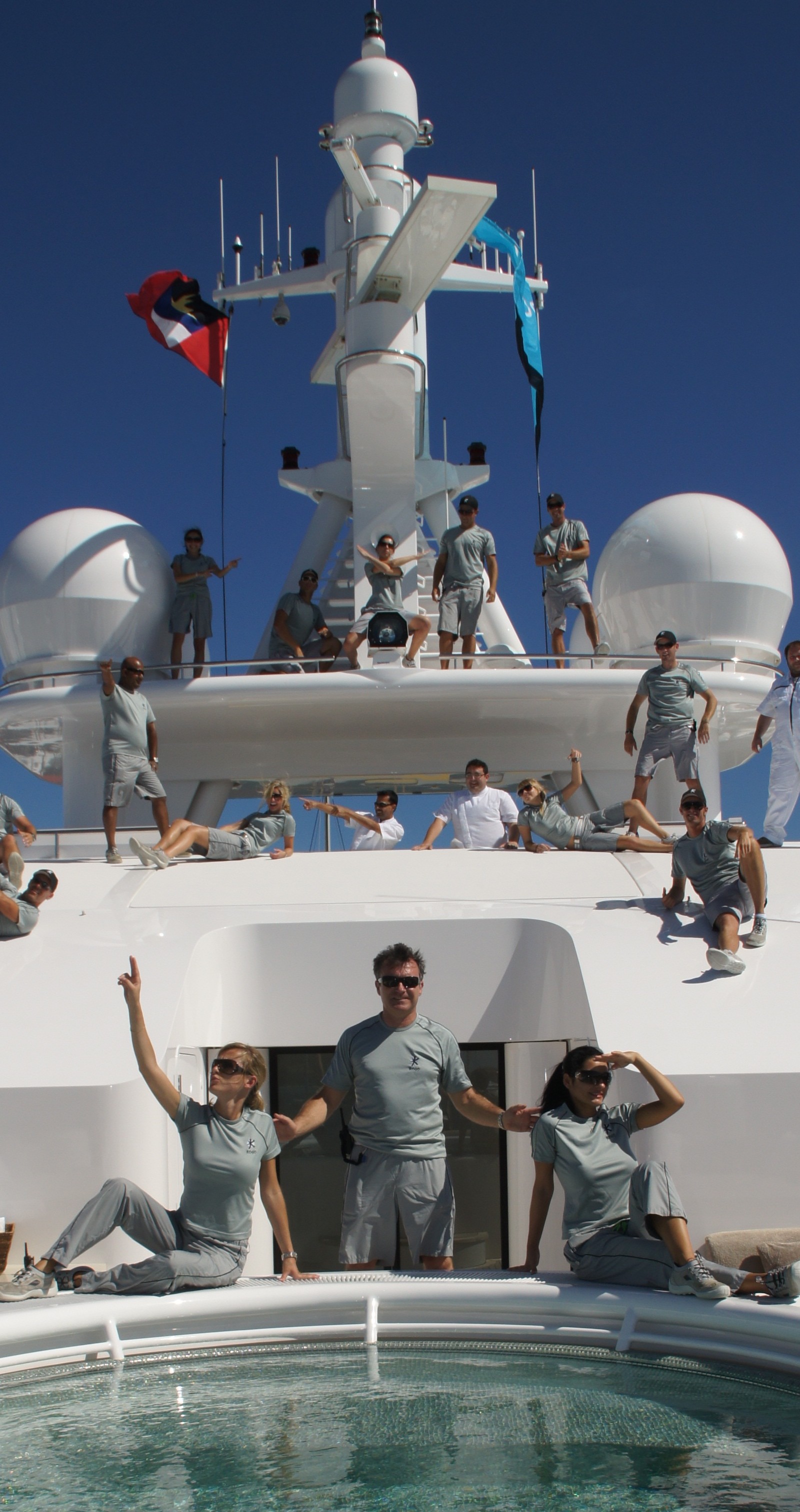
From the Blog Subscribe Now
Working on Cruise Ships vs. Superyachts – A Vast Sea of Difference
October 5, 2022 By Julie Perry
Here’s an excerpt from The Insiders’ Guide to Becoming a Yacht Stewardess: Confessions from My Years Afloat with the Rich and Famous :
I Must Confess…
We yachties sort of frowned upon what life might be like aboard the ol’ cruise ships..
We were attempting to exit a small port in Bermuda when the yacht I was working on got stuck behind a massive cruise liner. Several of my fellow crewmembers and I were seated on the bow (that’s the front end) of our boat observing as the cruise ship workers scrambled to herd on last-minute stragglers from their day’s excursion ashore.
A disembodied voice bellowed out from the speakers, instructing passengers to line up at “the starboard embarkation point on Deck DD-2 near the Happy Day Lounge.” Or something like that.
We watched and listened in horror before one of our deckhands finally spoke up. He made the comparison between cruise ships and superyachts as being similar to Target vs. Neiman Marcus.
To top that, one of my fellow stewardesses chimed in with, “Or perhaps even more appropriately: Walmart vs. the Gucci store on the Champs Élysées in Paris.”
I thought that was an accurate analogy. (She said it, I didn’t.)

Image credit: Pursuitist.com
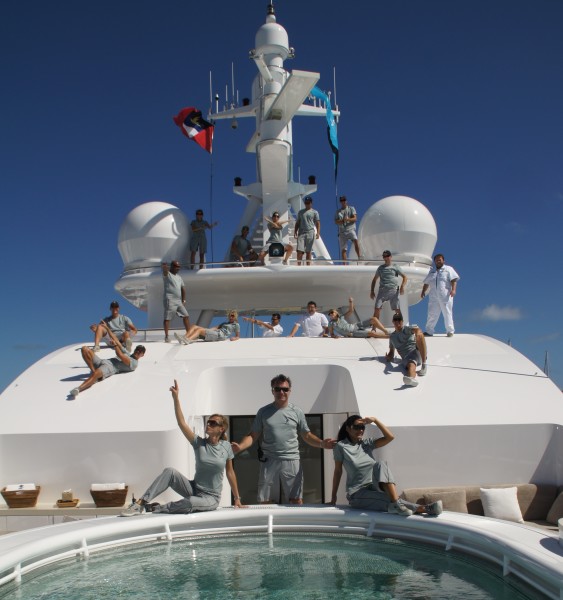
© Suki Finnerty Yachting Today TV
Read more yacht crew confessions from Julie Perry by picking up a copy of her book, The Insiders’ Guide to Becoming a Yacht Stewardess, 2nd Edition .
“The what industry?”
No matter how distinct and straightforward I tried to put it — “I work in the luxury-yachting industry” — this answer was always met with blank stares.
I would rephrase my response to be more specific: “I’m a stewardess on a luxury megayacht.”
“Ohhh,” they would nod (un)knowingly, “like a cruise ship.”
Ugh! That dreaded comparison.
It was inevitable. I could never just state my vocation and have people get it right away.
I suppose it makes sense that my friends back home wouldn’t be familiar with the yachting industry, or at least that it wouldn’t pop readily into their minds. Let’s face it: Everyone knows about employment opportunities that exist on cruise ships. But the same opportunities (and I call them golden opportunities) to work aboard luxury yachts seem to remain unheard of.
Why is that?
Even if you have never traveled on a cruise ship before, you have no doubt been subjected to the trillions of dollars worth of advertising done by the large cruise lines, inviting the masses to come aboard and “live the life of luxury.” Nearly everyone has been exposed to the all-affordable cruise line vacation and knows what it must be like to travel on these floating resorts.
So, when I told my friends I worked on a superyacht, cruise ships were their most obvious point of reference. They clearly picked up on some key similarities between the two types of jobs.
When I said I was a yacht stewardess, they gathered that:
- I worked on some type of boat.
- that boat was a pleasure cruising vessel on which people vacationed.
- I provided service for the vacationing guests aboard this pleasure cruiser.
What my friends perhaps didn’t pick up on was that:
- the boat I worked on was privately owned and privately chartered: more like a floating palace than a floating resort.
- the pleasure cruising vessel I worked on was owned and visited by some of the world’s wealthiest, and oftentimes most famous, people—the type for whom money is no object. And note: Most of them wouldn’t be caught dead on a cruise ship.
- the service I was hired to provide for guests was expected to be as top-notch as it comes—five-star quality, if not six. Sure, the duties might be similar to working on a cruise ship: serving food, making beds, cleaning, and doing laundry… But as a stewardess on a yacht, I handled all of these tasks, not just some of them. I also carried them out to much higher standards; nothing short of impeccable pampering was delivered. And the most unique part: I was providing this service to only a small number of people—a maximum of 12 on any given trip, with a crew-to-guest ratio that was nearly 1:1.
- oh yeah, and I got paid boatloads of money to travel by sea to some of the most beautiful and exotic ports in the world .
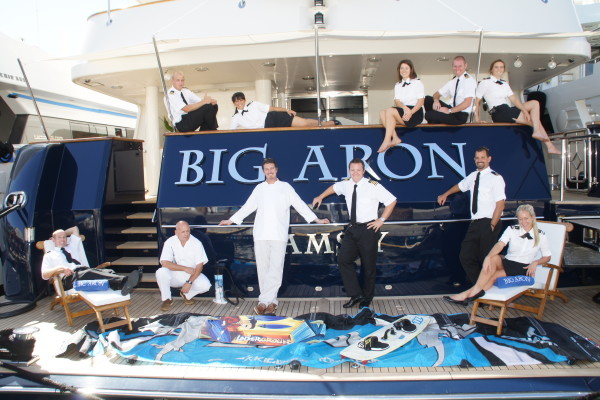
Superyacht Crew of M/Y “Big Aron” – circa 2011 Photo by Suki Finnerty of Yachting Today TV
Why Work on a Cruise Ship When You Can Work on a Luxury Yacht Instead?
To me, this is a no-brainer. On luxury yachts, the posh clientele, the unique travel opportunities, and more important, the money you can earn and the luxurious surroundings you live within make for an entirely different work environment than on commercial cruise liners. Sure, the service expectations are much higher on yachts; but if you are dedicated and receive the proper training , you can land a job on a yacht just as easily as you can on a cruise ship.
I’m not putting down the cruise line industry. After all, given my income level, if I were to take a vacation at sea, it would be my wallet’s best option. What I am trying to point out is that commercial cruises are for The Everyman. They are marketed to the masses, and therefore we are all familiar with them, both as a form of vacation and as a form of employment. So when comparing the cruise industry to the yachting industry—and more specifically, the jobs one would hold in either—then yes, yacht professionals do wish to remain in a far separate category.
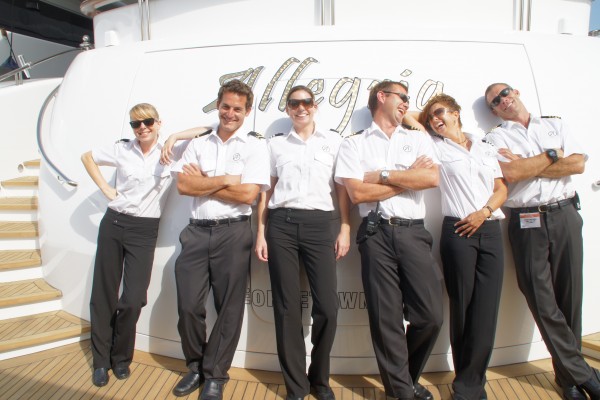
The Crew of Megayacht “Allegria” (2010). Photo by Suki Finnerty of YachtingToday.TV
Moreover, when it comes to payoffs for the crew, yacht jobs take the cake. Base salaries for stewardesses, when compared with those of food and beverage servers, cabin stews, and laundry staff on cruise ships, are slightly higher. But where the potential income differences become dramatic is when you consider the tips one can earn working on luxury charter yachts , or the bonuses and perks afforded the crew on solely private yachts.
For more on the benefits to your bank account, check out Chapter 2 of The Insiders’ Guide to Becoming a Yacht Stewardess . Meanwhile, I can tell you now with total confidence: The money and other perks you can obtain working on luxury yachts beats those offered on cruise ships hand over fist.
Cruise Ships vs. Luxury Yachts—A Vast Sea of Difference
Here’s a more direct comparison of working on cruise ships vs. superyachts:
Cruise Ships vs. Superyachts
And there you go! If the pay and benefits that come from accompanying the rich and famous on their private journeys around the world is news to you—and appeals to you—then that’s where I come in. Consider me your coach on how to become a part of it all.
But let’s get one thing straight right now: I will make no attempt to hide my passion for what I consider to be one of the world’s greatest jobs. Oh, and to all my dear friends back home in Indiana, I NEVER WORKED ON A CRUISE SHIP.
Read more yacht crew confessions from Julie Perry by picking up a copy of her boo k, The Insiders’ Guide to Becoming a Yacht Stewardess, 2nd Edition.
Don’t want to wait? Start learning more about what it’s really like to live and work “ below deck ” with a career in the luxury yachting industry by downloading Chapter 1 here .

About Julie Perry
Our latest tweets, get our email newsletter.
- Name * First Last
- Name This field is for validation purposes and should be left unchanged.

By SuperyachtNews 16 Jul 2021
An increase in cruise-ship crew applying for superyacht roles
How should the industry respond to this trend brought about by the pandemic.
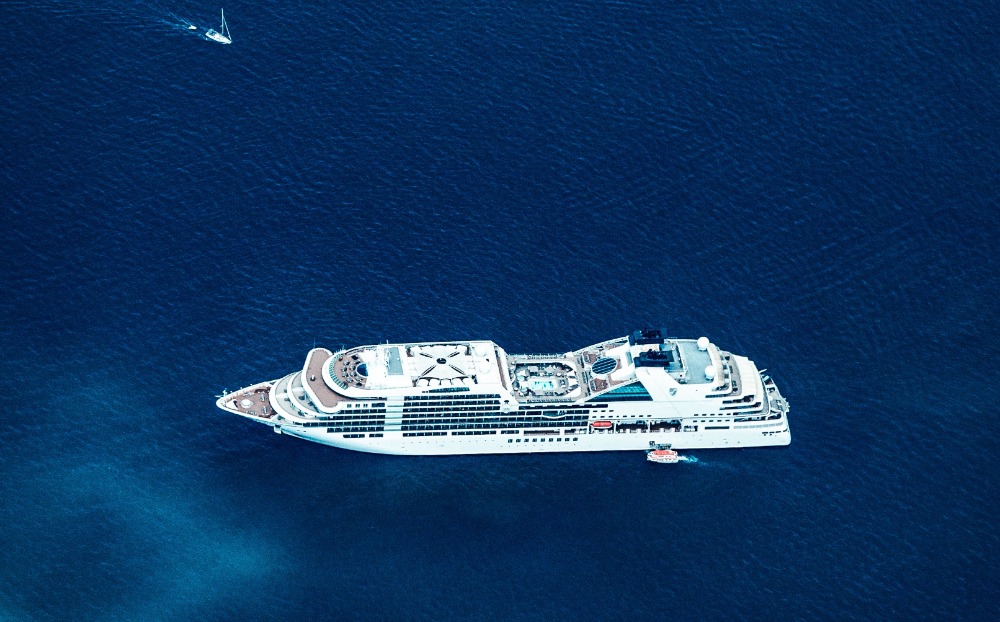
The coronavirus pandemic has devastated the cruise-ship sector, with widespread disruption and cancellations leaving thousands of cruise-ship crew without work and no date to return. Consequently, these crew have been exploring alternative avenues, and a natural move for many has been towards the superyacht industry. Recruitment agencies in the industry are reporting a significant increase in job applications across all departments from crew with backgrounds on cruise ships.
“The cruise-ship industry is looking to restart, but most companies will be starting with a smaller fleet, so there are definitely crew who are unsure if they’re going to go back to cruise ships, particularly on the hotel side, but even those with technical experience,” says Paul Rutterford, operations director at Viking Crew. “There’s a perception that the yachting industry hasn’t been affected by the pandemic and is, therefore, seen as a strong employment option.”
While the superyacht industry has, of course, been hit by the pandemic, albeit to a lesser extent than other industries, an influx of cruise-ship candidates may be of great benefit as many will have highly desirable skills and qualifications. On the deck and engineering side, most officers from a cruise background will have an unlimited ticket, so will be fully qualified for a role within their rank on a yacht – a significant advantage for their job search. “Especially on the engineering front,” says Laurence Lewis, director at YPI Crew. “These candidates have high certificates to operate cruise ships and their skills are sought after.”
Rutterford adds, “They are going to have lots of training that is, in many ways, more than what they will need on yachts. For example, if you work for a big cruise company, you might have done some bridge resource management training, which is all about team-building. A yacht won’t have a team as big as that but all of that training is still going to be valuable.”
John Wyborn, director at Bluewater, cautions that, if these crew haven’t any previous yachting experience, one area in which deck officers might be lacking is boat-handling. “Officers who have worked their way up on a superyacht have normally done a lot of tender driving and operations, and are usually good boat-handlers when it comes to berthing the yacht,” he says. “Some merchant navy officers, by contrast, don’t always have as much experience in ship-handling because much of this is done by harbour pilots and tugs.”
With a growing number of boutique luxury cruise ships taking to the water prior to the pandemic, the gap between the service provided on board the top-end cruise ships and superyachts is narrowing...
There are other factors to consider for those cruise-ship crew applying for interior roles. With a growing number of boutique luxury cruise ships taking to the water prior to the pandemic, the gap between the service provided on board the top-end cruise ships and superyachts is narrowing. Peter Vogel, founder and managing director of Luxury Hospitality, previously worked as a butler and steward on board both luxury cruise ships and superyachts for more than 20 years. For him, the key difference between interior crew from the cruise-ship industry and those in the superyacht industry is their hospitality training.
“The cruise-ship companies have serious training programmes and so a lot of these crew are trained to the max,” says Vogel. “The cruise-ship industry doesn’t accept people without training, whereas the yachting industry accepts anyone and mostly selects on attitudes and characteristics – for example, whether someone is going to click with the crew – and trains them on board. Superyachts don’t specifically look for a hotel or restaurant background, and so the people that are now going to come in from the cruise industry will bring experience and skill with them, which is very much needed.”
Another big difference between the two industries with regards to interior crew is that cruise-ship crew will have very specialist experience (as a bartender or housekeeper, for example), whereas they will need to do a bit of everything on a yacht. “In that sense, there’s definitely some learning that they would need to do in the superyacht environment,” adds Wyborn.
While cruise-ship crew may have a range of advantageous skills and training that could be transferable into yachting, there are also may be challenges. As well as receiving a significant increase in the number of registrations from cruise-ship crew, Yotspot had many of them ask for advice and clarification on how to transition across. Daryl Bradley, director of Yotspot, explains that most of these discussions focus on expectations versus reality.
“Some of them think yachting is an easy option, so we need to manage those expectations,” says Bradley. “Working in yachting can be far harder than commercial. On a cruise ship, officers have their own cabins and you know exactly when you’re going to be home. A lot of the people I spoke to also expected a three-months-on, three-months-off contract, so we have been trying to explain that there are very few rotational roles in yachting compared to the cruise industry, especially since the pandemic. It is a fantastic industry to work in and the rewards are there, but there needs to be a level of flexibility and a level of hospitality in their nature. It’s very difficult to just pick and choose a role in an industry that is already oversubscribed.”
“Cruise-ship crew have such in-depth training and they would bring an awful lot of skills and knowledge with them into yachting, which is really good for the industry...”
While there’s always been an intake of crew from the commercial and cruise industries to superyachts, the pandemic presents a significant opportunity for the industry to attract talented and career-minded crew from a commercial or cruise background who are out of work now through no fault of their own. As such, it’s important that the industry recognises their strengths and takes advantage of this moment in time.
“It’s a fantastic development and long overdue,” says Vogel. “Bringing this experience from the service side or the room-attendant side is only going to benefit our industry. When they come on board, we will obviously still need to fine-tune them and help them to understand what yachting is all about. But at the same time, they will have a quicker onboarding because we don’t have to teach them how to carry plates or serve people.”
“Cruise-ship crew have such in-depth training and they would bring an awful lot of skills and knowledge with them into yachting, which is really good for the industry,” agrees Wyborn. “But they don’t have the full package – they won’t know how to keep a top coat looking amazing, how to varnish or how to drive a tender unless they have had a lot of watersports experience in their private lives.”
However, to make the most of this opportunity there needs to be a shift in mindset towards recruiting crew from outside the industry. Wyborn adds that many captains don’t even think about hiring crew from other sectors. “They’ll look at whether they’ve got the necessary paperwork rather than looking at what their experience actually is and what that might mean if they were to transfer into yachting. A lot of these candidates from other industries won’t have the full package but it’s important to recognise their transferable skills.”
Vogel concludes, “I wish recruiters and captains would be more openminded to proper hospitality experience and bring that into our industry, because we desperately need more. We currently have a great industry that is working, but it can be improved. I just hope that the pandemic has actually opened up a lot of people’s eyes and is making them realise that we can change and improve things if we would just look outside our industry.”
This is a preview of an article that appears, in full, in the recently-published The Superyacht Captains Report . To access The Superyacht Captains Report and be part of The Superyacht Group Community, please click here .
Profile links
Viking Crew
Luxury Hospitality Management
Join the discussion
To post comments please Sign in or Register
When commenting please follow our house rules
Click here to become part of The Superyacht Group community, and join us in our mission to make this industry accessible to all, and prosperous for the long-term. We are offering access to the superyacht industry’s most comprehensive and longstanding archive of business-critical information, as well as a comprehensive, real-time superyacht fleet database, for just £10 per month, because we are One Industry with One Mission. Sign up here .
Related news
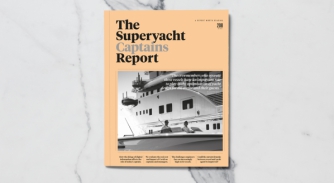
The Superyacht Captains Report
Out now, The Superyacht Captains Report tackles the most pertinent issues for superyacht crew today

COVID-19 vaccinations for superyacht crew
Some owners are requesting crew are vaccinated and making their continued employment contingent on it
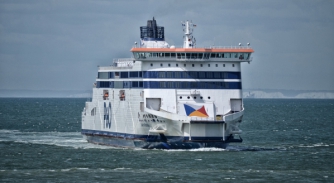
In the engine room: from ferries to superyachts
Engineer Josh Chapman discusses his transition from P&O Ferries to yachting in light of the pandemic
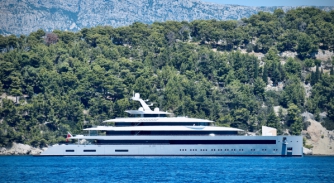
Increasing number of crew looking to unlimited certification
One such crewmember discusses the condensed experienced-seafarer route to an OOW Unlimited ticket

Managing crew welfare on M/Y Starfire
Captain Paul Duncan reflects upon the on-board mental health challenges caused by the pandemic

The impact of COVID-19 on crew recruitment in 2020
Laurence Lewis, director of YPI Crew, on the effects COVID-19 and her predictions for the year ahead
3 years ago
Sign up to the SuperyachtNews Bulletin
Receive unrivalled market intelligence, weekly headlines and the most relevant and insightful journalism directly to your inbox.
Sign up to the SuperyachtNews Bulletin
The superyachtnews app.

Follow us on
Media Pack Request
Please select exactly what you would like to receive from us by ticking the boxes below:
SuperyachtNews.com
Register to comment

The global authority in superyachting
- NEWSLETTERS
- Yachts Home
- The Superyacht Directory
- Yacht Reports
- Brokerage News
- The largest yachts in the world
- The Register
- Yacht Advice
- Yacht Design
- 12m to 24m yachts
- Monaco Yacht Show
- Builder Directory
- Designer Directory
- Interior Design Directory
- Naval Architect Directory
- Yachts for sale home
- Motor yachts
- Sailing yachts
- Explorer yachts
- Classic yachts
- Sale Broker Directory
- Charter Home
- Yachts for Charter
- Charter Destinations
- Charter Broker Directory
- Destinations Home
- Mediterranean
- South Pacific
- Rest of the World
- Boat Life Home
- Owners' Experiences
- Interiors Suppliers
- Owners' Club
- Captains' Club
- BOAT Showcase
- Boat Presents
- Events Home
- World Superyacht Awards
- Superyacht Design Festival
- Design and Innovation Awards
- Young Designer of the Year Award
- Artistry and Craft Awards
- Explorer Yachts Summit
- Ocean Talks
- The Ocean Awards
- BOAT Connect
- Between the bays
- Golf Invitational
- Boat Pro Home
- Superyacht Insight
- Global Order Book
- Premium Content
- Product Features
- Testimonials
- Pricing Plan
- Tenders & Equipment
10 of the biggest superyacht conversions
Related articles, superyacht directory.
It's not easy to transform a vessel built for function into a thing of beauty. But, if done right, the results can be magnificent. From naval frigates to ice-breaking tugs, we take a look at the top ten largest superyacht conversions to date...
1. Yas | 141m
Yas was first delivered in 1978 as a naval frigate named HNLMS Piet Hein . After two decades of service in the Dutch Royal Navy and a decade serving the UAE military, she was released from duty and converted into a private yacht under the codename Swift 141. Jacques Pierrejean is the man behind her futuristic design which includes a giant glass dome. The entire project was carried out in Abu Dhabi and the vessel was extended by 12 metres to accommodate a new pool deck. In 2011, she was relaunched in Port Zayed in Abu Dhabi and is the 11th largest yacht in the world .
2. Maryah | 125m
The 125 metre former Russian research vessel sailed under the names Dalmorgeologiya , Fortune and Czar , before she was converted into a SOLAS-compliant superyacht by Greek shipyard Elefis in 2015. Details of her interiors have been closely guarded but are said to feature a cinema and accommodation for 54 guests across her six decks.
3. Alexander | 121.95m
Alexander first splashed in 1965 and served as a cruise liner until 1985 when, after several changes of ownership, she was converted into a superyacht by Greek shipping tycoon John Latsis. She was extensively refitted in 1985 and then again in 1998, with accommodation for up to 80 guests in 40 staterooms. Highlights include a swimming pool, hospital, gymnasium, a 27-seat cinema and a helicopter landing pad.
4. Project Y910 | 120m
Built in Poland in 1990, the 90 metre vessel served as an offshore supply ship named after the Russian writer Vladimir Chivilikhin . The ship was in service until 1998 when its owner decided to convert the vessel into a luxury per-cabin charter yacht under the project name KAY. Work on the hull began at Keppel Singmarine before the yacht made its way to Italy for outfitting at Fincantieri. The half-built project was put up for auction in November 2021. Currently lying at the Fincantieri shipyard in Trieste, she patiently awaits a new owner.
5. Turama | 116.41 m
Christened Delfin Caravelle, the 116 metre vessel was delivered as a passenger ship in 1990 by Finnish shipyard Rauma and converted into a luxury charter yacht in 2004. Little is known about the conversion of Turama .
6. Dream | 106.5m
The 106.5 metre Dream was born into the world as a humble passenger vessel before she embarked on a near decade-long conversion project to fulfil the lifelong dream of an ambitious new owner. Under the project name Poseidonos, work began in 2008 at Chalkis Shipyards in Greece with exterior design by Studio Vafiadis and an all-new interior by Ciarmoli Queda Studio. The team's efforts were rewarded when Dream picked up a Neptune for Best Converted Yacht at the 2019 World Superyacht Awards .
7. Christina O | 99.15m
Christina O was built for the Canadian Navy as an anti-submarine frigate under the name HMCS Stormont . After surviving in the second world war, she was purchased for scrap value by Greek shipping magnate Aristotle Onassis, who then converted her into the legendary Christina O . A six-year conversion ensued and she was reborn in 1954 as an ultra-luxury private yacht that was regularly seen to host royalty and the Hollywood A-list with the likes of Greta Garbo, Marilyn Monroe, Frank Sinatra, Sir Winston Churchill, Grace Kelly, John F Kennedy and Elizabeth Taylor welcomed on board.
8. Voyager | 91.4m
Previously known as Danah Voyager , the conversion of this former offshore supply ship is the largest to take place on American soil. First delivered by Swiftships in 1997, the 63 metre commercial vessel arrived in Dania Cut in Florida in 2016 and emerged from the sheds three years later as a 90 metre explorer with five decks, 70 crew and a dive centre.
9. Dubawi | 90.6m
Dubawi began life in 1989 as a small passenger ship built by Cantieri Navale Ferrari before she was converted into a private yacht two decades after her launch. The project was awarded to Dubai shipyard Platinum Yachts and remains one of its biggest projects to date, second only to the 162 metre Dubai . Work included a five-metre extension, a restructuring of the top deck and an entirely new interior.
10. Lauren L | 90m
Built by Cassens-Werft in 2002, Lauren L began life as a cruise ship sailing under the name Constellation . After four years in service, she was bought by Liveas Yachts who converted her into a modern charter yacht with the capacity to carry a maximum of 40 guests.
More about this yacht
Yachts for charter, more stories, most popular, from our partners, sponsored listings.
- Inquire Now
- YACHT SEARCH
- Motor Yachts
- Sailing Yachts
- $1 – $25,000 Yachts
- $26,000 – $50,000 Yachts
- $50,000 – $100,000 Yachts
- $101,000 – $200,000 Yachts
- $200,000 – ∞ Yachts
- Turks and Caicos
- Virgin Islands
- Spain & Balearic Islands
- New England
- Tahiti & South Pacific
- More destinations
- Charter Advice
Yacht Charter vs Cruise Ship
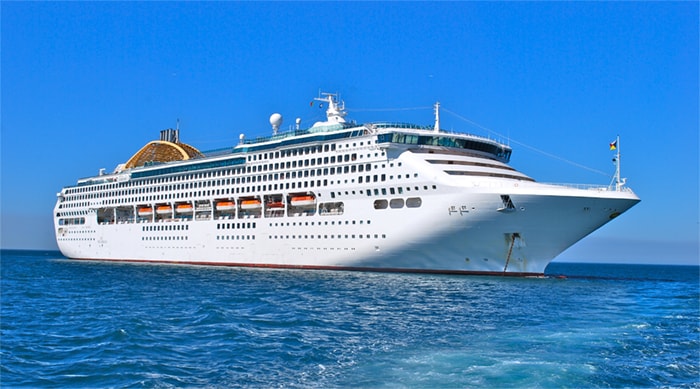
Yacht Charters vs. Cruises: What’s the Difference?
A vacation at sea seems like the ultimate escape. Guests get to explore beautiful coastal destinations aboard a sailing yacht, catamaran or cruise ship and enjoy the open ocean.
When it comes to a seafaring holiday, travelers have two options: A cruise ship vs. a yacht charter.
Although these types of vacations share some similarities, they couldn’t be more different. Whereas cruises have set itineraries and serve groups of more than 3,000 guests, luxury yacht charters offer a more intimate and personalized experience. Yacht charter guests, for example, receive unparalleled service, amazing chef-prepared cuisine, they can plan completely customizable itineraries, and they have access to more exclusive ports in the world’s top luxury destinations.
Bottom line: If you want to explore beaches, islands and port towns around the world, consider a private yacht charter and enjoy an experience you won’t soon forget.
Here are some of the key differences between cruises and yacht charters:
- Explore More
Due to their size, cruise ships must stop in larger and deeper ports. For example, in the Virgin Islands , cruise ships can only access the largest ports like Charlotte Amalie (USVI) and Tortola (BVI). Therefore, cruise guests miss out on the smaller, more exclusive islands and destinations in those areas like Jost Van Dyke and Virgin Gorda.
Private charter yachts, though, don’t require such large ports, and therefore, yacht charters can go to smaller islands, hidden beaches, secluded anchorages, and dive spots away from the cruise ship crowds. Not to mention, larger charter yachts typically have a tender onboard, and therefore, guests can motor up to virtually any beach or cove.
- Enjoy the Ultimate in Privacy
The majority of cruise ships accommodate more than 3,000 passengers. These guests all share the same amenities and dining room spaces, and as such, a cruise tends to feel crowded.
Yacht charters, though, are much more intimate. Just you and your guests are sharing the yacht (along with your dedicated crew). Therefore, you can spread out and relax, and avoid the crowds and lines you’d likely experience on a cruise.
Due to the crowds and shared activity and dining spaces, cruise ships are notorious for spreading germs and viruses. That’s a real concern for travelers, especially with the world’s new COVID-19 realities. Not to mention, social distancing is all but impossible on a cruise.
Charter yachts offer a much safer experience. For example, charter yachts are cleaned and disinfected before and during each charter, helping to limit the spread of disease. You can plan your vacation to be fully social-distanced – i.e. arriving on a private flight, avoiding crowded restaurants and ports, etc. And because you control the guest list, you know your fellow passengers won’t be spreading disease.
- Itinerary Flexibility & Customization
On a cruise ship, the itinerary and your onboard activities are typically set in stone. As such, you might have to miss out an activity or port of call that you had wanted to experience.
Yacht charter guests have much more freedom. Guests can control virtually any aspect of a yacht charter, including:
- Itineraries – Pick what you see and where you stay
- Menus – Help your chef plan the menu to your tastes
- Shore Excursions – Explore the places you’d like when in port
- Daily Schedule – Design your days to best suit your tastes, e.g. meal times, activities, etc.
- Exceptional Service
Yacht charters deliver a truly 5-star experience. Aboard a yacht, you’ll be served by a dedicated crew. In fact, most crewed yachts have a crew-to-guest ratio of one-to-one. That means you’ll always have a stewardess to top off your drinks, help you plan shoreside excursions, and provide top-notch meal service.
You’ll also have access to a deck crew that can help you plan and set up water sports, tender excursions, and beach picnics.
- Amazing Food & Drink
Charter guests are served by an onboard chef, who will design menus to meet your exacting preferences. In fact, prior to embarking, guests provide the chef with their food and beverage preferences. The chef then uses this information to develop menus that meet the guests’ preferences to a T. Available food and drink options include: tasting menus, pairings, themed dinners, birthday celebrations and more.
- More Activities and Water Sports
On cruises, the shore excursions are limited. One reason is time. You might only have a few hours in port, before you’re required to be back onboard. Another reason is the size the cruise ship. You won’t have access to the water, like you do onboard a charter yacht.
Charters provide guests with an amazing list of activities to enjoy. In fact, most charter yachts have an array of water sports toys and equipment for guests to enjoy, including jet skis, tenders, snorkel and scuba gear, and water slides. Another benefit: Charter guests have much more freedom to plan shoreside activities.
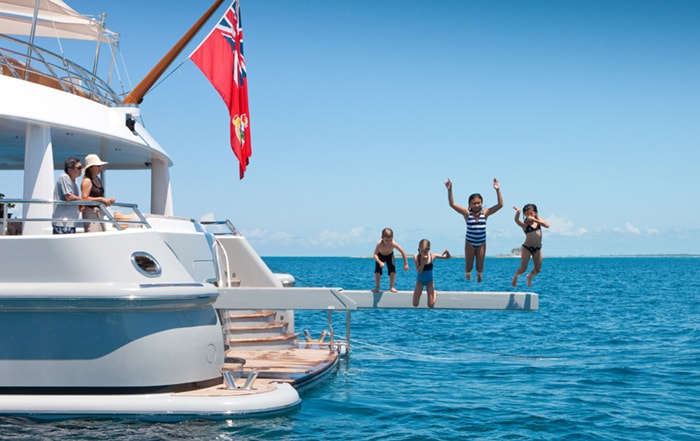
Ready to Plan Your Luxury Yacht Charter Vacation?
When it comes to vacations at sea, a yacht charter offers the best in privacy, customization, and service. Considering a yacht charter? Contact a broker with Worldwide Boat.
We provide yacht charters of all types in some of the world’s top yachting destinations including the Caribbean, the West Mediterranean, New England, and Greece. Let us help you plan a luxury yacht charter today.
Showing 1–4 of 286 results
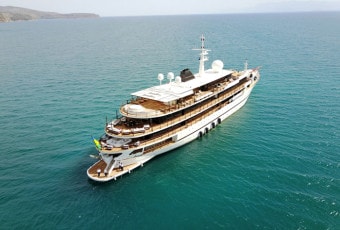
282.2ft / 84m
278.1ft / 83m
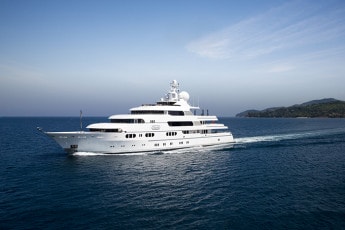
239.6ft / 71m
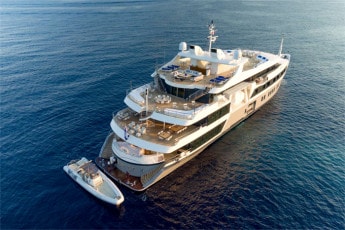
Serenity 236
236.3ft / 70m
Set your search criteria to find the perfect yacht
- Alaska Australia Bahamas BVI Caribbean Croatia Florida France Galapagos Greece Indonesia Italy Malaysia Maldives Mexico Mediterranean New England Norway Spain Thailand Tahiti Turkey
- Motor Yacht Catamaran Sailing Boats
- 2 4 6 8 10 12 12+
Search by yacht name
- Election 2024
- Entertainment
- Newsletters
- Photography
- Personal Finance
- AP Investigations
- AP Buyline Personal Finance
- AP Buyline Shopping
- Press Releases
- Israel-Hamas War
- Russia-Ukraine War
- Global elections
- Asia Pacific
- Latin America
- Middle East
- Election Results
- Delegate Tracker
- AP & Elections
- Auto Racing
- 2024 Paris Olympic Games
- Movie reviews
- Book reviews
- Personal finance
- Financial Markets
- Business Highlights
- Financial wellness
- Artificial Intelligence
- Social Media
Cruise ship sails into New York City port with 44-foot dead whale across its bow
- Copy Link copied
NEW YORK (AP) — A cruise ship sailed into a New York City port with a 44-foot (13-meter) dead whale across its bow, marine authorities said.
The whale, identified as an endangered sei whale, was caught on the ship’s bow when it arrived at the Port of Brooklyn on Saturday, National Oceanic and Atmospheric Administration fisheries spokesperson Andrea Gomez said.
A spokesperson for MSC Cruises said the whale was on the MSC Meraviglia, which docked at Brooklyn before sailing to ports in New England and Canada.
“We immediately notified the relevant authorities, who are now conducting an examination of the whale,” officials with the cruise line said in a statement.
“We are deeply saddened by the loss of any marine life,” the officials said, adding that the Geneva-based MSC Cruises follows all regulations designed to protect whales, such as altering itineraries in certain regions to avoid hitting the animals.
The dead whale was relocated to Sandy Hook, New Jersey, and towed to shore there to allow for better access to equipment and to conduct a necropsy, Gomez said.
The necropsy, an autopsy on an animal, was conducted on Tuesday, Gomez said. Samples collected from the whale will help biologists determine whether it was already dead when it was struck by the ship, she said.
Sei whales are typically observed in deeper waters far from the coastline, Gomez said. They are one of the largest whale species and are internationally protected.
- Share full article
Advertisement
Supported by
A Boat Designed to Be a Breath of Fresh Air
The creators of the latest vessel from Azimut Yachts went to great lengths to reduce its emissions, but even they won’t call it green.

By Ian Volner
Reporting from Milan
This article is part of our Design special section about water as a source of creativity.
In the middle of Milan Design Week last month, in the middle of the Bagni Misteriosi — a historic bathing complex in the Porta Romana neighborhood — the Italian luxury shipbuilder Azimut Yachts hosted an unusual exhibition. It was a celebration of the company’s latest offering: the Seadeck 6, which made its debut last year and features interiors by the design team of Matteo Thun and Antonio Rodriguez.
Having been lowered into the facility by crane, the nearly 60-foot vessel was set afloat in an outdoor swimming pool. There it bobbed, traversed by hordes of well-coiffed guests while a concealed apparatus shrouded it in bursts of atmospheric steam. Surreal, elegant, not a little absurd, it was a scene straight out of Fellini, with overtones of Werner Herzog’s boat-hoisting epic “Fitzcarraldo.”
But the thing that made it most unusual? “Azimut wanted to make this the most sustainable boat on the market,” Mr. Rodriguez said. “We tried to do that.”
The ultimate playthings for the ultrawealthy, high-end pleasure craft would not seem optimal candidates for greening. Yet a growing number of manufacturers and designers are trying to change that, producing yachts both large and (comparatively) small assembled from fewer and less carbon-intensive materials, requiring a fraction of the power to run and drawing more of their energy from renewable sources.
In a peculiar twist for an industry uniquely exposed to supply-chain shocks and the vicissitudes of geopolitics (the loss of the once-lucrative Russian market continues to smart), global brand leaders appear to be making the move toward energy efficiency of their own accord, rather than in response to any explicit demand from their clientele.
“We will have to see if the world is ready,” said Giovanna Vitelli, Azimut’s chairwoman, as she stood aboard the Seadeck 6 during its not-quite maiden, not-quite voyage.
It is an approach that entails some risk. In January, Silent Yachts — an Austrian solar-electric catamaran company with facilities in Fano, Italy — was reported to be approaching bankruptcy amid problems with both its corporate parent and a key subcontractor. A former client stepped in to rescue the brand from insolvency, yet challenges remain. In a recent interview with the trade publication Superyacht News, the company’s new chief operating officer, Fabrizio Iarrera, spoke of the “costs associated with creating an entirely new market.”
Still, the push toward more sustainable yachting appears to be barreling forward, part of a broader shift in the role of design in the industry. Seven years ago, Bonetti/Kozerski Architecture in New York — known for its plush hotel interiors for the hospitality magnate Ian Schrager — was invited by Azimut’s sister company Benetti to develop a new yacht concept, the Oasis. It was one of the rare instances in which Benetti, founded in 1873, had sought out collaborators with no previous maritime experience, and all parties took it as an opportunity to import a set of values they viewed as lacking in the boating world.
According to Enrico Bonetti, the architecture firm’s co-founder, boat design previously favored grand spaces that no one actually liked. “There’s always this big table nobody’s using, then you step into another place with shiny things,” he said. “We didn’t follow that.” With its open, airy living space, wood paneling and notable lack of gold leaf, the Oasis represented a more humane vision for the yacht of the future, one constrained by at least the appearance of refinement and reserve, though it was ritzy nonetheless.
That low-key tendency is very much in line with the decarbonization campaign now underway at Azimut and other builders. In recent years, design studios like Zaha Hadid Architects and Pininfarina have turned out yacht proposals that pair sleek visuals with reduced reliance on fossil fuels; later this year, Yves Béhar, the Swiss-born product and furniture maestro, will unveil his own take on the trend — a catamaran designed for an as-yet unnamed manufacturer. “It’s essentially an E.V.,” said Mr. Béhar, who was also in Milan for the design fair.
Underlying the designer eco-yacht phenomenon is the intuitive sense, as Antonio Rodriguez put it, that “silent luxury” is fast displacing opulence. Where previous generations of yachters sought to flaunt their wealth, today’s owners may be less keen to draw attention to their own affluence. In reducing their carbon footprint, boatmakers are hoping to lure customers eager to reduce their profile, while still allowing them to ply the seven seas in style.
The Seadeck 6 certainly does that. With a crisp, white exterior — the work of the veteran yacht designer Alberto Mancini — the ship sleeps up to eight in three below-deck cabins. Topside, guests can sprawl in fore and aft lounges, or take lunch prepared in a semi-concealed galley, served on an elegant foldout table. The interior palette is muted, the contours soft, and everywhere, Ms. Vitelli said, the intention was to let people “feel close to water” rather than immuring them in an oceangoing penthouse.
Relatively speaking, the Seadeck’s ecological credentials are also impressive. Nearly every feature has been retooled for minimal environmental impact: replacing the customary teak deck with sustainably sourced cork; covering the walls and upholstering the seating with organic and recycled materials; even sealing the hull with something the company refers to as an ‘eco-gel finish.’” Most important, the craft incorporates a still-novel (for marine propulsion) hybrid engine, capable of a top speed of 33 knots with the ability to navigate about 200 miles offshore — enough for a quick spin from Fort Lauderdale to the Bahamas.
Add it together, and the company claims the Seadeck 6 and its larger cousin, the 71-foot Seadeck 7, achieve an operational carbon output 60 percent that of comparable vessels.
It’s a start, but only that. A comparative analysis with a similarly sized Azimut product — coupled with statistics from the Environmental Protection Agency — suggests that the cruise from Fort Lauderdale to Nassau would contribute roughly 4,400 pounds of carbon dioxide on the Seadeck 6, well over what the average American produces in a month.
And then there are the more immediate costs: around $2.8 million for the Seadeck 6 and $4.25 million for the Seadeck 7. Ms. Vitelli said the company hopes that enough buyers will come aboard to make price reductions possible in future.
A lot is riding on these hopes. Elsewhere in Milan, at the giant exhibition hall of the Salone del Mobile furniture fair, a talk session with a group of yacht experts underscored the stakes: During the panel, Stefano de Vivo, the chief commercial officer of the luxury yacht brand Ferretti Group, presented a slide showing Italy’s dominance in the custom-yacht sector, with domestic manufacturers taking a large share of the $9 billion global marketplace.
Mr. de Vivo declared sustainability essential to shipbuilding’s ongoing success and spoke of a general convergence with the design field at large. “As a shipyard, we’ve had to become less ‘marine,’” he said.
Back at the Bagni Misteriosi, mariners did seem in somewhat short supply, as various design lovers and Salone personalities (including the celebrated architect Michele de Lucchi, who helped create an on-site installation for Azimut) swanned around the bathhouse garden and its waterborne centerpiece. As an image of an ecologically sensitive future, the spectacle seemed off the mark — but then the Seadeck’s creators are careful not to make any overly sweeping claims as to whether their yacht, or any yacht for that matter, can truly be deemed an ecological asset.
“We don’t really like the word ‘sustainable,’” Mr. Rodriguez said. “We prefer to say it’s ‘conscious.’”

IMAGES
VIDEO
COMMENTS
The first thing to note is that cruise ships are generally much larger than super yachts. The average cruise ship is about 900 feet (ca. 274 meters) long, while the average super yacht is only about 150 feet (ca. 46 meters) long. This difference in size means that there are also differences in the number of crew members.
If you've been thinking about traveling and working at sea, but you're wondering about the difference between cruise ship vs superyacht life, this post is for you. Here's a quick breakdown of the key differences between working on a superyacht and working on a cruise ship.
SuperYacht Times. 28.1K subscribers. Subscribed. 199. 5.3K views 2 years ago. SuperYacht Times founder Merijn de Waard delves into the controversial topic of the difference between...
November 1, 2023. Many travelers look at luxury yacht rentals and cruise ships when planning a vacation at sea. But there are some major distinctions between these two options. Understanding the key differences can help you choose the best one to suit your needs and expectations.
Table of Contents. Yacht vs Cruise Ship. For starters, yachts are generally much smaller than cruise ships. Yachts also tend to be more luxurious, and they often have a more intimate atmosphere onboard. Cruise ships, on the other hand, are typically large vessels that can accommodate hundreds or even thousands of passengers.
In this sense, therefore, luxury cruise ships are moving closer to superyachts while superyachts are getting closer to cruise ships. The 167m M/Y Eclipse , for example, is nothing less than a modern cruise vessel in terms of dimensions, propulsion systems, in-board systems and plants, safety and security systems and on-board ...
As cruise ship and superyacht designs have become increasingly similar, there has been some confusion about what a cruise ship, passenger vessel, and a superyacht are. Though some may look like superyachts and are even designed by superyacht designers, such as Njord and Somnio , they are actually quite distinct from yachts and the terms cruise ...
The most obvious difference is size. While yachts can be quite large—superyachts often exceed 100 feet in length—cruise ships are significantly larger. Some of the biggest cruise ships can carry more than 6,000 passengers and 2,000 crew members. Amenities. Both yachts and cruise ships offer luxury amenities, but the scope differs greatly ...
Introduction. When it comes to luxury travel, there are various options available, but two that often stand out are yachts and cruise ships. Both offer unique and extravagant experiences, allowing travelers to explore the open waters in style.
Differences far outweigh similarities in comparing a yacht vs. cruise ship charter, but nonetheless the query comes up from time to time. In our opinion, a yacht charter attracts a very different type of vacationer than a cruise ship. Yacht Vs. Cruise Ship - Similarities Stop at the Water's Edge.
Compare cruise ship sizes by length, weight (tonnage), height, width/beam. Review cruise ship dimensions in both meters and feet, and FAQ information, definitions.
Short Answer. Yachts are smaller, private vessels that are designed for luxury leisure and recreational activities, such as sailing and fishing. Cruises are large, commercial ships that are designed to transport passengers on longer voyages and are often used for leisure activities like sightseeing and entertainment.
A superyacht, sometimes known as a mega yacht, is a high-end, privately owned sailing or motor vessel with a professional crew. Depending on the owner's fortune, a super yacht may tour the world, winter in the South Pacific, or spend the summer in the Mediterranean. A cruise ship is just one of many ships in a fleet owned by large companies like Carnival Cruise Lines or Norwegian Cruise ...
SuperYacht Times founder Merijn de Waard delves into the controversial topic of the difference between superyachts and cruise ships as the lines blur between ... Easy Branches allows you to share your guest post within our network in any countries of the world to reach Global customers start sharing your stories today! Home; About; Contribute; Contact Us; Easy Branches. 34/17 Moo 3 Chao fah ...
Winner: Tie. You're paying for more space, and you'll get it with either option. Cabin choices shouldn't factor too prominently in your decision. A ship-within-a-ship is likely the better option if you're looking for a cabin that will provide more Instagram-ready photo opportunities. If you want more elegance, stick with a luxury line. Dining.
Superyacht: Tonnage: 9,932 GT; 2,979 NT; Displacement: 8,850 t: Length: 126.20 m (414 ft 1 in) Beam: 21.00 m (68 ft 11 in) Draft: 5.76 m (18 ft 11 in) Ice class: 1A: Installed power: 8 diesel engines; total 19,200 hp (14,300 kW) Propulsion: 2 propellers: Speed: 19 knots (35 km/h; 22 mph) max: Range: 12,500 nmi (23,200 km; 14,400 mi ...
Meanwhile, I can tell you now with total confidence: The money and other perks you can obtain working on luxury yachts beats those offered on cruise ships hand over fist. Cruise Ships vs. Luxury Yachts—A Vast Sea of Difference . Here's a more direct comparison of working on cruise ships vs. superyachts: Cruise Ships vs. Superyachts
What's the difference? Cruising As Crew. 63.8K subscribers. Subscribed. 345. 5.5K views 2 years ago. Hey sailors, The majority of you that watch my videos are interested in working on cruise...
Which is where the small cruise ship-with-superyacht notion fills a gap in the market. The brands leading the way Arguably the world's most exclusive hotel chain, Aman, has always been ahead of ...
16 Jul 2021. An increase in cruise-ship crew applying for superyacht roles. How should the industry respond to this trend brought about by the pandemic? The coronavirus pandemic has devastated the cruise-ship sector, with widespread disruption and cancellations leaving thousands of cruise-ship crew without work and no date to return.
Physical Differences. Design Difference. Speed Differences. Variations in Atmosphere. Ocean Liners. Why Aren't More Ocean Liners Being Built? Changes in Cruise Ship Designs. Differences Between...
Alexander first splashed in 1965 and served as a cruise liner until 1985 when, after several changes of ownership, she was converted into a superyacht by Greek shipping tycoon John Latsis. She was extensively refitted in 1985 and then again in 1998, with accommodation for up to 80 guests in 40 staterooms. Highlights include a swimming pool, hospital, gymnasium, a 27-seat cinema and a ...
Here are some of the key differences between cruises and yacht charters: Explore More. Due to their size, cruise ships must stop in larger and deeper ports. For example, in the Virgin Islands, cruise ships can only access the largest ports like Charlotte Amalie (USVI) and Tortola (BVI).
Updated 11:02 AM PDT, May 8, 2024. NEW YORK (AP) — A cruise ship sailed into a New York City port with a 44-foot (13-meter) dead whale across its bow, marine authorities said. The whale, identified as an endangered sei whale, was caught on the ship's bow when it arrived at the Port of Brooklyn on Saturday, National Oceanic and Atmospheric ...
May 10, 2024, 5:01 a.m. ET. This article is part of our Design special section about water as a source of creativity. In the middle of Milan Design Week last month, in the middle of the Bagni ...